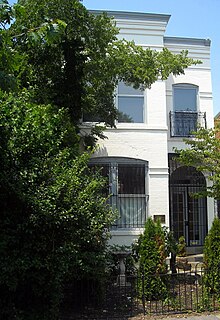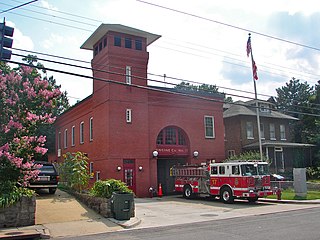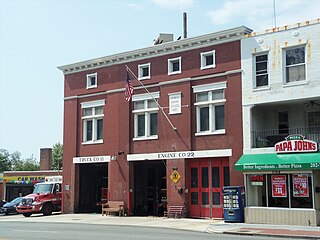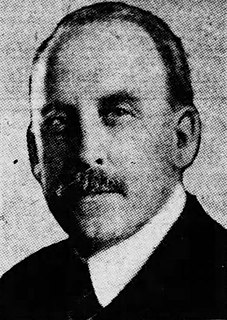
The Washington Navy Yard (WNY) is the former shipyard and ordnance plant of the United States Navy in Southeast Washington, D.C. It is the oldest shore establishment of the U.S. Navy.

Logan Circle is a traffic circle park, neighborhood, and historic district in the Northwest quadrant of Washington, D.C. The primarily residential neighborhood includes two historic districts, properties listed on the National Register of Historic Places, and sites designated D.C. Historic Landmarks. Vermont Avenue NW, Rhode Island Avenue NW, 13th Street NW, and P Street NW meet at the circle. An equestrian statue of Major General John A. Logan stands at its center. It is the only major circle downtown that remains entirely residential.

Petworth is a residential neighborhood in the Northwest quadrant of Washington, D.C. It is bounded to the east by the Armed Forces Retirement Home and Rock Creek Cemetery, to the west by Arkansas Avenue NW, to the south by Rock Creek Church Road NW and Spring Road NW, and to the north by Kennedy Street NW.

Streetcars in Washington, D.C. transported people across the city and region from 1862 until 1962.

The Charles Sumner School, established in 1872, was one of the earliest schools for African Americans in Washington, D.C. Named for the prominent abolitionist and United States Senator Charles Sumner, the school became the first teachers' college for black citizens in the city and the headquarters of its segregated school system for African American students. It currently houses a small museum, a research room, art exhibits, and the archives of the District of Columbia Public Schools.

The Evans-Tibbs House is an historic house in the Shaw neighborhood of Washington, D.C. It has been listed on the District of Columbia Inventory of Historic Sites since 1985 and it was listed on the National Register of Historic Places in 1987. It is a contributing property in the Greater U Street Historic District.

Engine Company No. 17 also known as Chemical Company No. 4 and the Brookland Firehouse, is a historic firehouse located at 1227 Monroe Street, NE, Washington, D.C. It was constructed in 1902 and housed an early “chemical company” which fought fires in outlying districts using large soda-acid extinguishers rather than using steam pumpers on the unreliable municipal water supply. The firehouse was innovative at the time of its construction, having a built-in electrical system, and it was designed to make use of the new call box system installed in the neighborhood. It was officially designated Engine Company 17 in 1905.

Old Engine Company No. 26, also known as the Langdon Firehouse and Chemical Company No. 3, located at 2715 22nd Street, NE, Washington, D.C. is a historic firehouse built in 1908 and listed on the National Register of Historic Places in 2007.

The Vigilant Firehouse is a historic building in the Georgetown section of Washington, D.C. located at 1066 Wisconsin Ave., NW, just north of the Chesapeake and Ohio Canal and the Canal Monument. The Vigilant Fire Company was organized in 1817 and this firehouse was built in 1844, making it the oldest extant firehouse in the District of Columbia. It was listed on the National Register of Historic Places in 1971.

Engine House No. 10 is a historic firehouse located at 1341 Maryland Ave., NE., Washington, D.C., in the Stanton Park neighborhood, just north of Capitol Hill.

Engine Company 22, also known as the Brightwood Firehouse, was a fire station at #5760 Georgia Ave NW and it is also a historic structure located in the Brightwood Park neighborhood in Washington, D.C. It was listed on both the District of Columbia Inventory of Historic Sites and on the National Register of Historic Places in 2011. The two-story brick building was designed by Leon E. Dessez and built in stages. It was initially completed in 1897 and then enlarged between 1907 and 1911. The current address of DCFD Engine Company 22 and Truck Company 11 is #6825 Georgia Ave NW.

Engine Company 21, also known as the Lanier Heights Firehouse, is a fire station or firehouse and a historic structure located in the Lanier Heights neighborhood in Washington, D.C. It was listed on the District of Columbia Inventory of Historic Sites in 2005 and on the National Register of Historic Places in 2007. The building is attributed to local architect Appleton P. Clark, Jr., and built in 1908 in the Spanish Colonial Revival style. The station was built to serve the growing suburban areas of Washington north of Florida Avenue, NW. Because of its proximity to numerous multistory apartment buildings it housed the longest hook-and-ladder truck in the city.

Engine Company 31, also known as the Forest Hills Firehouse, is a fire station and an historic structure located in the Wakefield neighborhood in Washington, D.C. It was listed on both the DC Inventory of Historic Sites and on the National Register of Historic Places in 2011. The brick building was designed by Albert L. Harris and built in 1931.

Engine Company 16-Truck Company 3 is a fire station and a historic structure located in the Downtown area of Washington, D.C. It was listed on both the District of Columbia Inventory of Historic Sites and on the National Register of Historic Places in 2011. The three-story brick building was designed by Albert L. Harris and built in 1932.

Engine Company 23 is a fire station and a historic structure located in the Foggy Bottom neighborhood of Washington, D.C. The two-story Italianate style building was a collaboration of the Washington, D.C. architectural firm of Hornblower & Marshall and District of Columbia Municipal Architect Snowden Ashford. It was built in 1910. The exterior of the structure features segmental-arched vehicle openings and quoined limestone frontispiece. It was listed on both the District of Columbia Inventory of Historic Sites in 2005 and on the National Register of Historic Places in 2007. The building sits on the campus of the George Washington University near Kogan Plaza.

Truck Company F, at 1336-1338 Park Rd. NW in Washington, D.C., was built in 1900. It was listed on the National Register of Historic Places in 2007. The listing included two contributing buildings.

Engine Company 29, at 4811 MacArthur Blvd. NW in Washington, D.C., is a fire station built in 1925. It was listed on the National Register of Historic Places in 2007.

Albert L. Harris was an American architect who worked primarily in Washington, D.C. He was born in Wales and emigrated to the United States as a young child. He worked for architectural firms in Chicago and Baltimore and then Washington, where he also obtained an architectural degree from George Washington University. He was a part-time professor there while also working for the US Navy and then the city of Washington where he served as the city's Municipal Architect from 1921 until his death in 1933. A number of his works are listed on the National Register of Historic Places (NRHP).

The Georgetown Car Barn, historically known as the Capital Traction Company Union Station, is a building in the Georgetown neighborhood of Washington, D.C., in the United States. Designed by the architect Waddy Butler Wood, it was built between 1895 and 1897 by the Capital Traction Company as a union terminal for several Washington and Virginia streetcar lines. The adjacent Exorcist steps, later named after their appearance in William Friedkin's 1973 horror film The Exorcist, were built during the initial construction to connect M Street with Prospect Street.






















